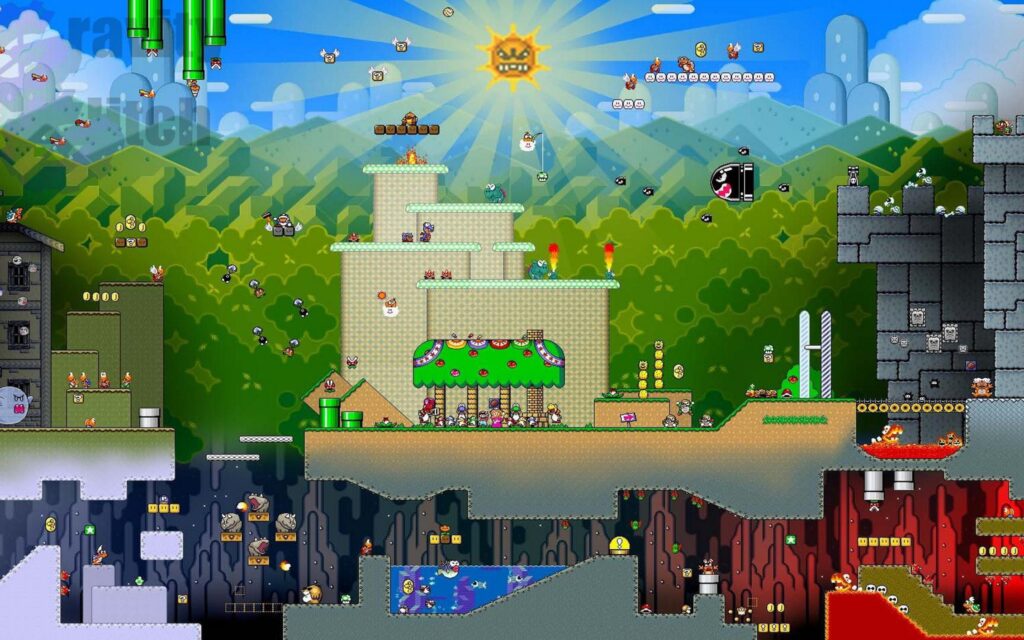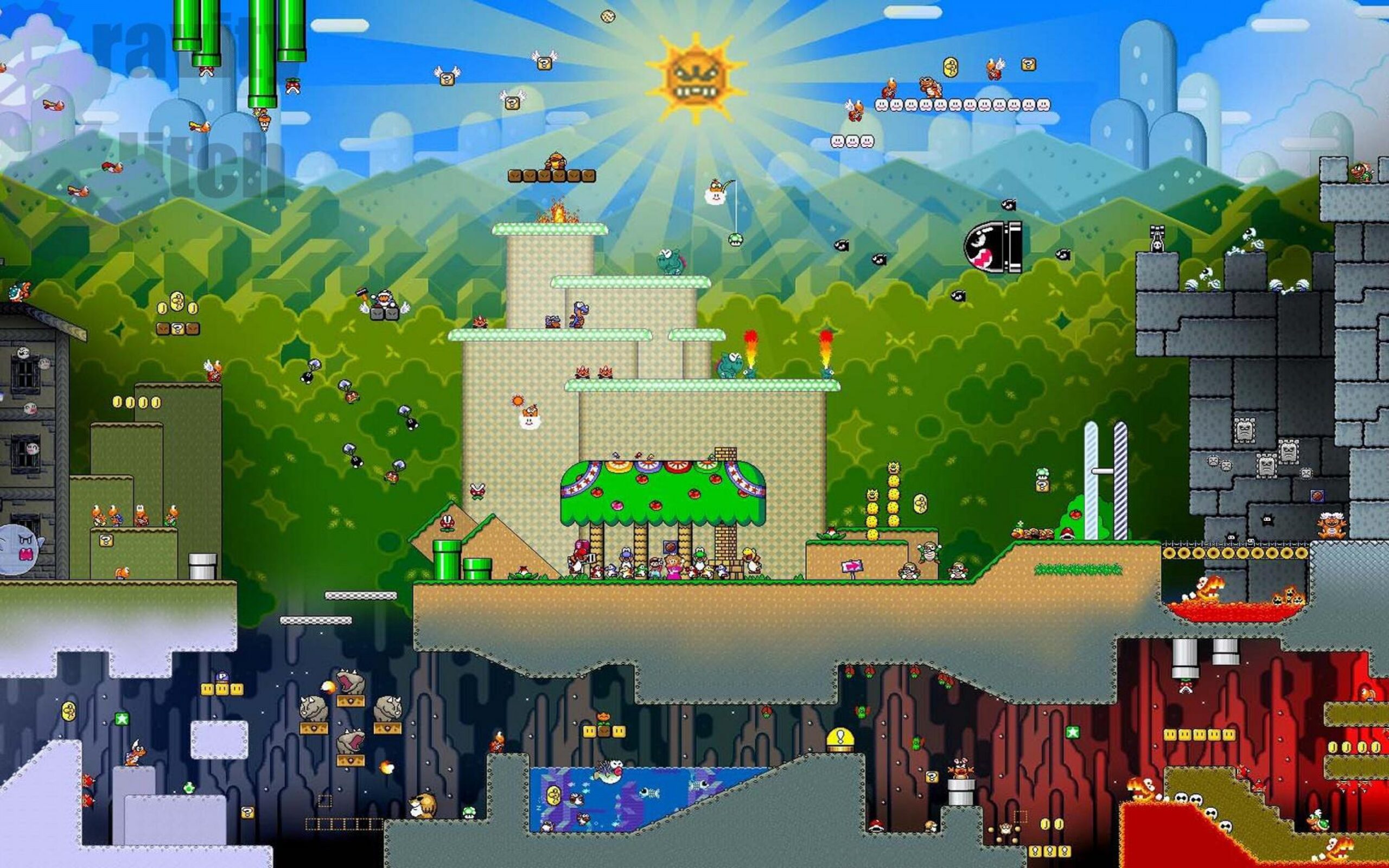
Exploring the Enchanting Mario Landscape: A Deep Dive into Iconic Worlds
The Mario landscape is more than just a backdrop; it’s an integral part of the Mario experience, shaping gameplay, narrative, and the overall feeling of adventure. From the lush greenery of the Mushroom Kingdom to the fiery depths of Bowser’s Castle, each environment is meticulously crafted to evoke specific emotions and challenge players in unique ways. This article will delve into the fascinating world of the Mario landscape, exploring its evolution, iconic locations, and the impact it has had on the gaming industry.
The Evolution of the Mario Landscape
The original Super Mario Bros. on the Nintendo Entertainment System (NES) introduced players to a relatively simple, yet charming, Mario landscape. The 8-bit graphics limited the detail, but the use of color and clever level design created memorable environments like World 1-1, a standard against which all platforming levels are often judged. As technology advanced, so did the Mario landscape. Super Mario World on the Super Nintendo Entertainment System (SNES) brought richer colors, more detailed sprites, and the introduction of new environments like Dinosaur Land.
The transition to 3D with Super Mario 64 was a monumental leap. Suddenly, players could explore the Mario landscape with complete freedom, discovering hidden secrets and interacting with the environment in unprecedented ways. Subsequent games like Super Mario Sunshine and Super Mario Galaxy further expanded the possibilities, introducing tropical islands and gravity-defying space environments, respectively. The Mario landscape continues to evolve with each new installment, pushing the boundaries of creativity and technical innovation.
Iconic Locations in the Mario Landscape
Certain locations within the Mario landscape have become instantly recognizable and deeply ingrained in popular culture:
- Mushroom Kingdom: The quintessential Mario landscape, characterized by its cheerful colors, friendly Toads, and iconic mushroom-shaped houses. It’s the starting point for many of Mario’s adventures and a symbol of hope and prosperity.
- Bowser’s Castle: The antithesis of the Mushroom Kingdom, Bowser’s Castle is a foreboding fortress filled with lava, traps, and menacing enemies. It represents the ultimate challenge for Mario and the culmination of his quest.
- World 1-1: More than just a level, World 1-1 from the original Super Mario Bros. is a piece of gaming history. Its simple yet effective design has been analyzed and replicated countless times, solidifying its place as one of the most iconic locations in the Mario landscape.
- Dolphin Shoals (Mario Kart 8): This underwater course is a beautiful example of how the Mario landscape can extend beyond the core platforming games. The vibrant colors and graceful dolphin animations create a serene and captivating experience.
- Rainbow Road: Appearing in various Mario Kart games, Rainbow Road is a visually stunning track that defies gravity and challenges players to navigate its treacherous curves. Its vibrant colors and ethereal atmosphere make it a memorable part of the Mario landscape.
The Impact of the Mario Landscape on Game Design
The Mario landscape has had a profound influence on game design, particularly in the platforming genre. Its emphasis on exploration, hidden secrets, and challenging level design has inspired countless developers to create their own unique and engaging worlds. The principles of level design established in the early Mario games continue to be relevant today, demonstrating the enduring legacy of the Mario landscape.
Furthermore, the Mario landscape has demonstrated the importance of creating a cohesive and immersive world. The consistent art style, memorable characters, and engaging gameplay all contribute to a sense of place that draws players in and keeps them coming back for more. This emphasis on world-building has become a cornerstone of modern game design, thanks in part to the pioneering work of Nintendo in creating the iconic Mario landscape.
Analyzing Key Elements of the Mario Landscape
Several key elements contribute to the overall appeal and effectiveness of the Mario landscape. These include:
Color Palette
The use of bright, vibrant colors is a hallmark of the Mario landscape. These colors create a cheerful and inviting atmosphere, making the games accessible to players of all ages. The contrast between the colorful Mushroom Kingdom and the darker, more menacing Bowser’s Castle further enhances the thematic elements of the games.
Level Design
The level design in the Mario landscape is meticulously crafted to provide a balance of challenge and reward. Levels are often filled with hidden secrets, power-ups, and challenging obstacles that encourage exploration and experimentation. The gradual increase in difficulty ensures that players are constantly learning and improving their skills.
Enemy Design
The enemies in the Mario landscape are just as iconic as the environments themselves. Goombas, Koopa Troopas, and other familiar foes provide a constant threat, but their predictable behavior allows players to learn their patterns and develop strategies for overcoming them. The variety of enemies ensures that players are always encountering new challenges and adapting their gameplay accordingly.
Music and Sound Design
The music and sound design in the Mario landscape are integral to the overall experience. The upbeat and catchy melodies create a sense of excitement and adventure, while the sound effects provide feedback and reinforce the player’s actions. The iconic themes have become instantly recognizable and are often associated with the Mario landscape itself.
The Future of the Mario Landscape
The Mario landscape continues to evolve and adapt to new technologies and gameplay mechanics. With the advent of virtual reality and augmented reality, the possibilities for creating even more immersive and interactive environments are endless. Nintendo has already experimented with these technologies, and it is likely that future Mario games will push the boundaries of what is possible in terms of environmental design.
Furthermore, the increasing emphasis on online multiplayer and social interaction is likely to influence the future of the Mario landscape. Imagine exploring a vast, interconnected world with friends, collaborating to solve puzzles and overcome challenges. This could lead to entirely new types of Mario games that blur the lines between single-player and multiplayer experiences.
The enduring appeal of the Mario landscape lies in its ability to transport players to a world of imagination and adventure. Whether it’s exploring the Mushroom Kingdom, battling Bowser in his fiery castle, or racing along Rainbow Road, the Mario landscape provides a consistently engaging and rewarding experience. As technology continues to advance, it will be exciting to see how Nintendo continues to innovate and expand upon this iconic world.
In conclusion, the Mario landscape is a testament to the power of creative world-building and innovative game design. Its enduring appeal and influence on the gaming industry are undeniable, and it will continue to inspire and entertain players for generations to come. The vibrant colors, challenging levels, and iconic characters all contribute to a unique and unforgettable experience that defines the essence of the Mario franchise. The Mario landscape is not just a game; it’s a cultural phenomenon.
From the simple 8-bit beginnings to the expansive 3D worlds of today, the Mario landscape has consistently evolved, offering new and exciting experiences for players. Whether you’re a long-time fan or a newcomer to the series, there’s always something to discover in the ever-expanding Mario landscape. Its impact on gaming is undeniable, and its future is bright. [See also: History of Platformer Games] [See also: The Evolution of Nintendo Consoles]

